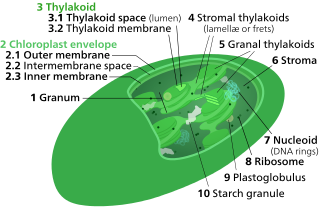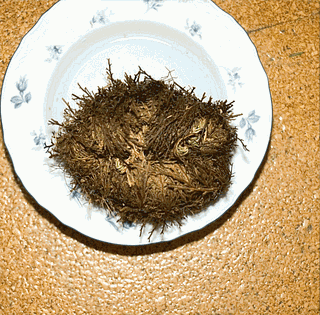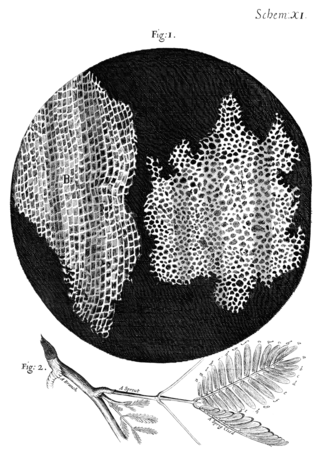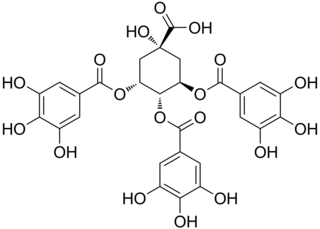
The endomembrane system is composed of the different membranes (endomembranes) that are suspended in the cytoplasm within a eukaryotic cell. These membranes divide the cell into functional and structural compartments, or organelles. In eukaryotes the organelles of the endomembrane system include: the nuclear membrane, the endoplasmic reticulum, the Golgi apparatus, lysosomes, vesicles, endosomes, and plasma (cell) membrane among others. The system is defined more accurately as the set of membranes that forms a single functional and developmental unit, either being connected directly, or exchanging material through vesicle transport. Importantly, the endomembrane system does not include the membranes of plastids or mitochondria, but might have evolved partially from the actions of the latter.

Lipids are a broad group of organic compounds which include fats, waxes, sterols, fat-soluble vitamins, monoglycerides, diglycerides, phospholipids, and others. The functions of lipids include storing energy, signaling, and acting as structural components of cell membranes. Lipids have applications in the cosmetic and food industries, and in nanotechnology.

The lipid bilayer is a thin polar membrane made of two layers of lipid molecules. These membranes are flat sheets that form a continuous barrier around all cells. The cell membranes of almost all organisms and many viruses are made of a lipid bilayer, as are the nuclear membrane surrounding the cell nucleus, and membranes of the membrane-bound organelles in the cell. The lipid bilayer is the barrier that keeps ions, proteins and other molecules where they are needed and prevents them from diffusing into areas where they should not be. Lipid bilayers are ideally suited to this role, even though they are only a few nanometers in width, because they are impermeable to most water-soluble (hydrophilic) molecules. Bilayers are particularly impermeable to ions, which allows cells to regulate salt concentrations and pH by transporting ions across their membranes using proteins called ion pumps.

Thylakoids are membrane-bound compartments inside chloroplasts and cyanobacteria. They are the site of the light-dependent reactions of photosynthesis. Thylakoids consist of a thylakoid membrane surrounding a thylakoid lumen. Chloroplast thylakoids frequently form stacks of disks referred to as grana. Grana are connected by intergranal or stromal thylakoids, which join granum stacks together as a single functional compartment.

Pleopeltis polypodioides, also known as the resurrection fern, is a species of creeping, coarse-textured fern native to the Americas and Africa.
Fatty acid metabolism consists of various metabolic processes involving or closely related to fatty acids, a family of molecules classified within the lipid macronutrient category. These processes can mainly be divided into (1) catabolic processes that generate energy and (2) anabolic processes where they serve as building blocks for other compounds.

Cytorrhysis is the permanent and irreparable damage to the cell wall after the complete collapse of a plant cell due to the loss of internal positive pressure. Positive pressure within a plant cell is required to maintain the upright structure of the cell wall. Desiccation resulting in cellular collapse occurs when the ability of the plant cell to regulate turgor pressure is compromised by environmental stress. Water continues to diffuse out of the cell after the point of zero turgor pressure, where internal cellular pressure is equal to the external atmospheric pressure, has been reached, generating negative pressure within the cell. That negative pressure pulls the center of the cell inward until the cell wall can no longer withstand the strain. The inward pressure causes the majority of the collapse to occur in the central region of the cell, pushing the organelles within the remaining cytoplasm against the cell walls. Unlike in plasmolysis, the plasma membrane maintains its connections with the cell wall both during and after cellular collapse.
Cardiolipin is an important component of the inner mitochondrial membrane, where it constitutes about 20% of the total lipid composition. It can also be found in the membranes of most bacteria. The name "cardiolipin" is derived from the fact that it was first found in animal hearts. It was first isolated from the beef heart in the early 1940s by Mary C. Pangborn. In mammalian cells, but also in plant cells, cardiolipin (CL) is found almost exclusively in the inner mitochondrial membrane, where it is essential for the optimal function of numerous enzymes that are involved in mitochondrial energy metabolism.

A resurrection plant is any poikilohydric plant that can survive extreme dehydration, even over months or years.
Lipid metabolism is the synthesis and degradation of lipids in cells, involving the breakdown and storage of fats for energy and the synthesis of structural and functional lipids, such as those involved in the construction of cell membranes. In animals, these fats are obtained from food and are synthesized by the liver. Lipogenesis is the process of synthesizing these fats. The majority of lipids found in the human body from ingesting food are triglycerides and cholesterol. Other types of lipids found in the body are fatty acids and membrane lipids. Lipid metabolism is often considered as the digestion and absorption process of dietary fat; however, there are two sources of fats that organisms can use to obtain energy: from consumed dietary fats and from stored fat. Vertebrates use both sources of fat to produce energy for organs such as the heart to function. Since lipids are hydrophobic molecules, they need to be solubilized before their metabolism can begin. Lipid metabolism often begins with hydrolysis, which occurs with the help of various enzymes in the digestive system. Lipid metabolism also occurs in plants, though the processes differ in some ways when compared to animals. The second step after the hydrolysis is the absorption of the fatty acids into the epithelial cells of the intestinal wall. In the epithelial cells, fatty acids are packaged and transported to the rest of the body.

Selaginella lepidophylla is a species of desert plant in the spikemoss family (Selaginellaceae). Known as a "resurrection plant", S. lepidophylla is renowned for its ability to survive almost complete desiccation. Resurrection plants are vascular rooted plants capable of surviving extreme desiccation, then resuming normal metabolic activity upon rehydration. The plant's hydro-responsive movements are governed by stem moisture content, tissue properties and a graded distribution of lignified cells affecting concentric stem stiffness and spiraling. During dry weather in its native habitat, its stems curl into a tight ball, uncurling only when exposed to moisture.

Cephaloridine is a first-generation semisynthetic derivative of antibiotic cephalosporin C. It is a Beta lactam antibiotic, like penicillin. Its chemical structure contains 3 cephems, 4 carboxyl groups and three pyridinium methyl groups.
Poikilohydry is the lack of ability to maintain and/or regulate water content to achieve homeostasis of cells and tissue connected with quick equilibration of cell/tissue water content to that of the environment. The term is derived from Ancient Greek ποικίλος ..
A xerophyte is a species of plant that has adaptations to survive in an environment with little liquid water. Examples are typically desert regions like the Sahara, and places in the Alps or the Arctic. Popular examples of xerophytes are cacti, pineapple and some Gymnosperm plants.
Desiccation tolerance refers to the ability of an organism to withstand or endure extreme dryness, or drought-like conditions. Plants and animals living in arid or periodically arid environments such as temporary streams or ponds may face the challenge of desiccation, therefore physiological or behavioral adaptations to withstand these periods are necessary to ensure survival. In particular, insects occupy a wide range of ecologically diverse niches and, so, exhibit a variety of strategies to avoid desiccation.
Membrane fusion is a key biophysical process that is essential for the functioning of life itself. It is defined as the event where two lipid bilayers approach each other and then merge to form a single continuous structure. In living beings, cells are made of an outer coat made of lipid bilayers; which then cause fusion to take place in events such as fertilization, embryogenesis and even infections by various types of bacteria and viruses. It is therefore an extremely important event to study. From an evolutionary angle, fusion is an extremely controlled phenomenon. Random fusion can result in severe problems to the normal functioning of the human body. Fusion of biological membranes is mediated by proteins. Regardless of the complexity of the system, fusion essentially occurs due to the interplay of various interfacial forces, namely hydration repulsion, hydrophobic attraction and van der Waals forces.

Cell theory has its origins in seventeenth century. microscopy observations, but it was nearly two hundred years before a complete cell membrane theory was developed to explain what separates cells from the outside world. By the 19th century it was accepted that some form of semi-permeable barrier must exist around a cell. Studies of the action of anesthetic molecules led to the theory that this barrier might be made of some sort of fat (lipid), but the structure was still unknown. A series of pioneering experiments in 1925 indicated that this barrier membrane consisted of two molecular layers of lipids—a lipid bilayer. New tools over the next few decades confirmed this theory, but controversy remained regarding the role of proteins in the cell membrane. Eventually the fluid mosaic model was composed in which proteins “float” in a fluid lipid bilayer "sea". Although simplistic and incomplete, this model is still widely referenced today.

3,4,5-Tri-O-galloylquinic acid is a hydrolysable tannin found in Lepidobotrys staudtii, in Guiera senegalensis or in the resurrection plant.
Jill Farrant, professor of molecular and cell biology at the University of Cape Town, South Africa, is a leading expert on resurrection plants, which 'come back to life' from a desiccated, seemingly dead state when they are rehydrated.

Craterostigma plantagineum, is a resurrection plant species in the genus Craterostigma. It is a dwarf growing plant and can be found to make a 'carpet' across the ground, with blooms in shades of blue and purple. It is a well-studied desiccation-tolerant species known for its extreme vegetative tolerance against dehydration and desiccation. It is native to parts of Africa and to India. It is known as a resurrection plant.














